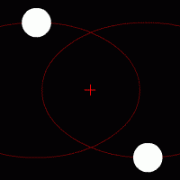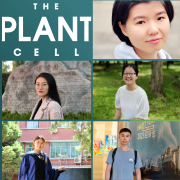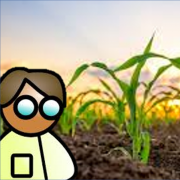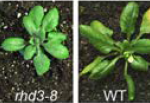Fantastic Collaborations and How to Find Them
Guest post by George Kantor, Senior Systems Scientist, Robotics Institute, Carnegie Mellon University
This much is a truism: a successful career in any interdisciplinary field requires collaboration with people from different disciplines. It is more difficult to define what skills are needed to be an effective collaborator. As an engineer who has been developing sensors and robots for agriculture for the past 20 years, I have had some fantastic collaborations. I’ve also had my share of professional relationships that didn’t work out. Through it all I learned a lot about how to find good partners, and how to work with them to find and solve good problems. The short answer is that it is not easy; it takes hard work and time and patience and a bit of luck. But the ability to find and navigate those relationships is critical to having future careers in SynBio or plant breeding or any other cutting-edge application-oriented scientific endeavor.
So, what does it take? First and foremost, master your own discipline. The good news is that the training and mentoring systems we use today work well in developing the skills and habits of a strong researcher within their own discipline. Work ethic, intellectual rigor, effective communication, and a deep understanding of the tools and methodologies of a chosen field are necessary for success in that field, and they form the foundation for interdisciplinary collaboration. People want to collaborate with you because you are good at things they are not, so it is important for you to get very good at something.
What can you bring to a collaboration? To answer that you need to know what it is that you are good at, and how to explain what you can do to other people.
It is also important to understand what it is you want to get out of a collaboration. Toward this end, you must develop a strong research vision within your own discipline. What is the big question you want to answer? What is the important problem you want to solve? How will you distinguish yourself relative to other people in your discipline? These are the things that drive a career, so finding them and keeping them in focus is necessary to keep moving in the direction you want to move in, especially when you start to work with people who have a very different set of motivations and goals.
As an engineer looking to collaborate with scientists, the inherent difficulty usually works out something like this: I have a set of tools I can use, and ideas about how I want to advance those tools. I have an idea of what kinds of new capabilities can be developed: which ones are hard to develop, and which ones are easy. I also have a rough idea of what kinds of problems my potential scientist collaborator wants to solve, but I have little understanding of the details and little insight into which solutions would be the most impactful.
The scientist understands the details and knows the relative importance of the various potential problems to solve. But here’s the thing: scientists usually do not understand the technical tools that are available nor the relative difficulty and risks associated with creating potential new solutions. If we are going to have a successful collaboration, we need to find an important problem that can be solved with a relatively easy new technical development. Together we know everything we need to find and solve the problem, but there is very little intersection of our knowledge bases. And as our knowledge bases rely heavily on jargon, we speak different languages.
I have found no formula to get past that barrier. The only way to do it is to talk. And listen. And keep talking and listening until we find what we are looking for. Sometimes it works, other times it doesn’t. But here are a few observations about the attitudes and approaches that have tended to work for me:
Shared Vision: This is the most important thing to establish early on in collaboration, and professional relationships tend to succeed or fail based on the strength of the shared vision. The shared vision doesn’t need to go into the details, but it does have to lay out the aims of the partnership and the role of the partners in broad strokes, and the partners must be passionate about their roles. When I got into rapid phenotyping, I knew I could put robots and sensors in the field, and it was something I was excited about doing. I found a collaborator who saw the potential for using big data to improve his breeding program, and a great partnership was born. It took a lot more work to turn that set of goals into a successful research program, but finding that shared vision was the first step.
Patience: Understand the depth of the communication challenge I have outlined above, and acknowledge that it will take time. Collaborative partnerships develop on timescales measured in years. Finding good problems takes many conversations, and often includes a few false starts. Keep trying, and go back to the shared vision if you need to remind yourself what the reward will be.
Respect: Your collaborator is an independent researcher with their own discipline-specific research program and goals, even if you don’t fully understand what they are. Engineering collaborators are not contractors hired to solve a problem for a scientist. Science collaborators are not there just to give an engineer interesting research motivation to help fund a project. All parties need to be devoted to the shared vision, but they also need to work together to craft the goals of their collaborative research project in a way that allows them all to advance their individual research agendas.
Curiosity: It is important to learn the basics of the challenges that your collaborators are working on. Ask questions, and don’t be afraid to ask very basic ones. I often find out what the collaborator’s favorite undergraduate textbook is, and start working my way through it, peppering my collaborator with questions along the way.
Patience (again): Take the time and effort to help your collaborators satisfy their curiosity about your field. This probably means that you will revisit concepts that you haven’t thought about in a long time, and you’ll have to find ways to explain them without the jargon short-hand you are used to.
Knowing when to quit: Sometimes it just doesn’t work out, and giving up on a collaboration that you invested a lot of time in can be one of the hardest decisions to make. It’s a good idea to check back in on your shared vision from time to time. Does it still make sense? Are you still excited about it? If not, it is probably time to move on. Sometimes the vision is good, but the collaboration still doesn’t work. Occasionally there are unresolvable personality differences. Sometimes collaborators don’t exhibit the patience, respect, and curiosity necessary to make the collaboration work. When these things happen, it’s usually best to wrap up your commitments and bring the collaboration to an end. Don’t worry, though, there will always be more problems to solve and more collaborators to solve them with!
 About the Author: George Kantor is a Senior Systems Scientist at Carnegie Mellon University’s Robotics Institute. He has over 20 years of experience research in developing and deploying robotic technologies for real-world applications such as agriculture, mining, and scientific exploration. In the agriculture domain, earlier research projects include the development of distributed sensor-actuator networks for intelligent irrigation control and the development of vehicles for autonomous navigation in specialty crop environments. One of his current efforts investigating in-field robotic phenotyping technologies that include autonomous mobility, camera imaging, and contact sensing to accelerate the breeding of bioenergy sorghum. Another project is using imaging in viticulture crops to provide non-destructive crop yield predictions, crop quality assessments, and pruning weight measurements. His group is exploring similar technologies in apple orchards, specifically pursuing automated apple detection to facilitate harvest from an automated harvest platform that carries human pickers. He also is dedicated to K-12 STEM educational outreach activities. https://www.ri.cmu.edu/ri-faculty/george-a-kantor/
About the Author: George Kantor is a Senior Systems Scientist at Carnegie Mellon University’s Robotics Institute. He has over 20 years of experience research in developing and deploying robotic technologies for real-world applications such as agriculture, mining, and scientific exploration. In the agriculture domain, earlier research projects include the development of distributed sensor-actuator networks for intelligent irrigation control and the development of vehicles for autonomous navigation in specialty crop environments. One of his current efforts investigating in-field robotic phenotyping technologies that include autonomous mobility, camera imaging, and contact sensing to accelerate the breeding of bioenergy sorghum. Another project is using imaging in viticulture crops to provide non-destructive crop yield predictions, crop quality assessments, and pruning weight measurements. His group is exploring similar technologies in apple orchards, specifically pursuing automated apple detection to facilitate harvest from an automated harvest platform that carries human pickers. He also is dedicated to K-12 STEM educational outreach activities. https://www.ri.cmu.edu/ri-faculty/george-a-kantor/










Leave a Reply
Want to join the discussion?Feel free to contribute!